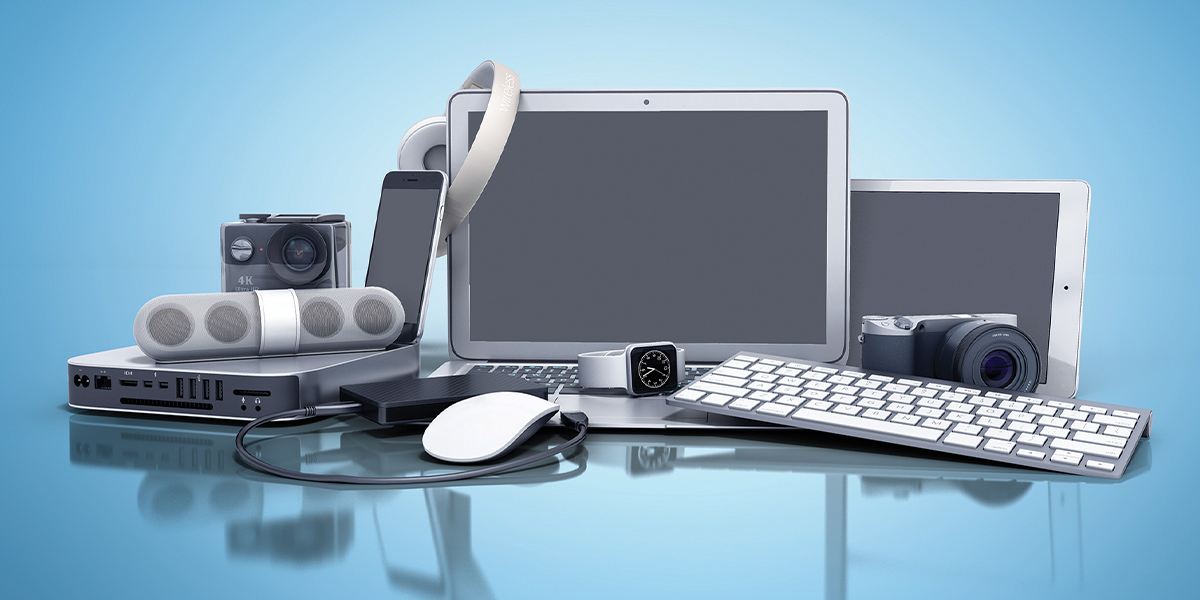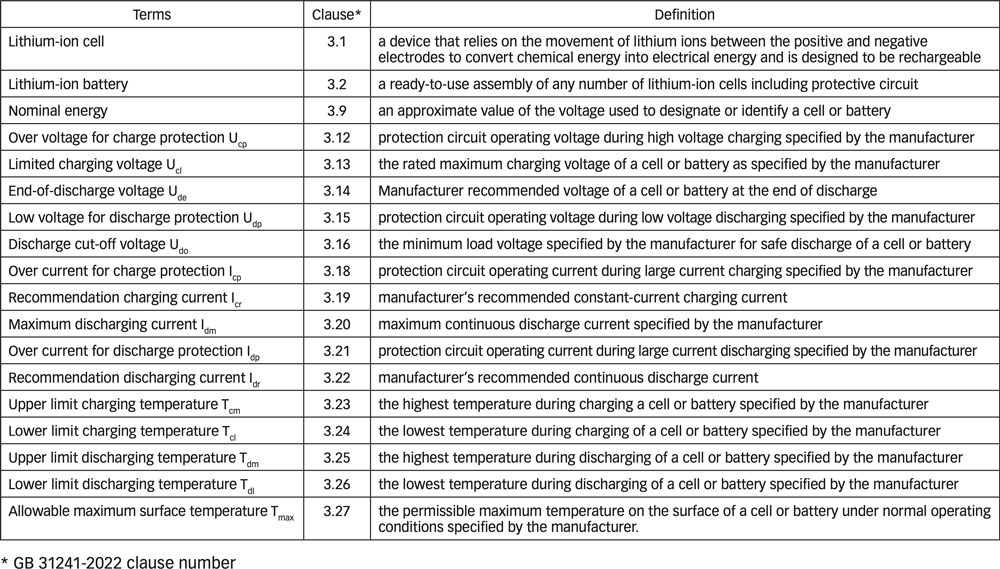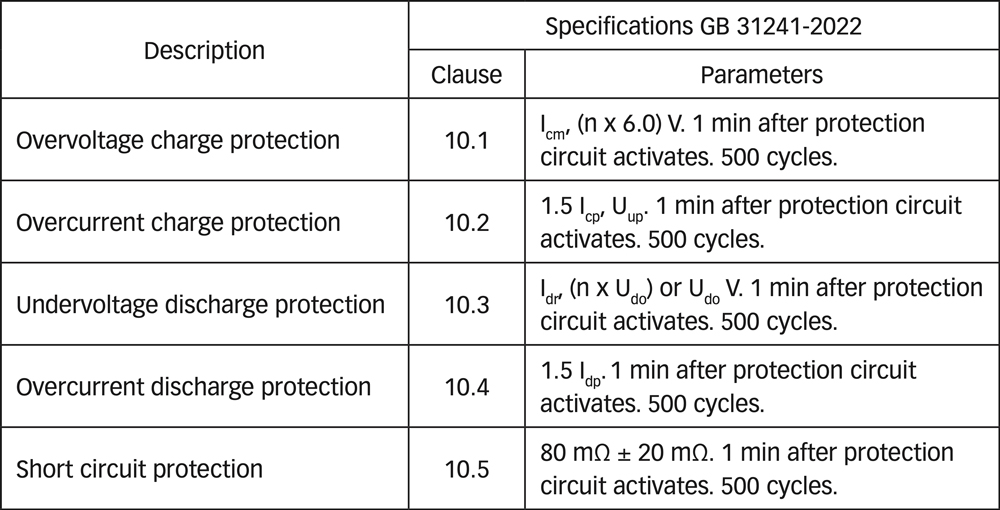
ithium-ion cells and batteries produced in or imported into China are now regulated in accordance with China’s Compulsory Certification (CCC) system. The China State Administration for Market Regulation (SAMR) announced CCC requirement for lithium-ion cells and batteries used in portable electronic equipment through Notice No. 10 issued in 2023.1 Effective August 1, 2024, all regulated lithium-ion cells and batteries must be CCC-certified for compliance with the requirements set forth in GB 31241.
GB 31241, “Lithium-ion cells and batteries used in portable electronic equipment – Safety technical specification,” was originally issued in 2014 and more recently replaced by the 2022 version, GB 31241-2022.2 GB 31241-2022 is not equivalent to any current international standard. However, relevant reference standards include, but are not limited to, IEC 62133-2:2017,3 UN 38.3 (7th Revision),4 and UL 1642:2020.5
GB 31241-2022 imposes new and updated requirements on manufacturers of lithium-ion cells and batteries. This article provides a summary of the requirements in GB 31241-2022 and guidance on their application.
- Portable office products: notebook computers, tablets, etc.;
- Mobile communications products: mobile phones, cordless telephones, walkie talkies, etc.;
- Portable audio/video products: portable televisions, portable audio/video players, cameras, video recorders, voice recorders, Bluetooth headsets, portable speakers, etc.; and
- Other portable products: electronic navigators, digital picture frames, game consoles, e-books, mobile power supplies, portable energy storage power supplies, portable projectors, wearable equipment, etc.
However, GB 31241-2022 is not applicable to lithium-ion cells and batteries used in electronic cigarettes.
Prior to testing, cells and batteries are subject to charging, discharging, and/or conditioning, as applicable. The manufacturer-specified charging procedure is preferred. An alternative charging procedure (which is new to this version) is to charge at 0.2 It A. When the terminal voltage reaches the limited charging voltage (Ucl), change to constant voltage charging until the charging current is less than or equal to 0.2 It A.
A cell or battery is discharged at a constant current of the recommendation discharging current (Icr) down to the end of discharge voltage (Ude). This discharge procedure is new and replaces the manufacturer-specified procedure.
Cells and batteries are to be conditioned with two charge-discharge cycles. The interval between charge and discharge is 10 minutes. New to the 2022 version of GB 31241 is the introduction of an electrostatic discharge (ESD) test for batteries equipped with protection circuits. In such cases, the ESD test must be conducted after two charge-discharge cycles and being fully charged, using a ± 4 kV contact discharge and ± 8 kV air discharge.
For batteries incorporating a protection circuit, additional test items, as listed in Table 3, apply.
For cells, the test sample remains on test until the surface temperature declines by 20 % of the maximum temperature rise, or for a period of 24 hours, whichever is sooner. Batteries with the protection circuit removed remain on test for 24 hours, while batteries with a protection circuit remain on test until the protection circuit activates.
During testing, monitor the cell temperature change. Terminate testing after either:
- The longer period of 7 hours or the charging time declared by the manufacturer, or
- The cell’s temperature declines by 20 % of the maximum temperature.
When there is a difference between the results of a) and b), those generated during the longer of the two options takes precedence.
A cylindrical cell is crushed with its longitudinal axis parallel to the flat surfaces of the crushing apparatus. A button cell is crushed with its upper and lower sides parallel to the flat surfaces of the crushing apparatus. For prismatic cells (hard shell), pouch cells with a length less than 25 mm, and other types of cells, perform the crush test only on the wide surface of the cell.
For pouch cells with a length not less than 25 mm, place a steel semi-cylinder with a diameter of 25 mm on the wide surface of the cell for crushing. The longitudinal axis of the semi-cylinder body passes through the geometric center of the wide surface and is perpendicular to the direction of the electrode tab. The length must be greater than the size of the crushed cell. Release the force once the crush force reaches the force listed in Table 10 of the standard. This test procedure is new to this version.
Batteries shall be sufficiently safe when used under high temperature conditions. To ensure compliance with this requirement, a fully charged battery is placed in a high temperature test chamber with the temperature set to the maximum value of:
- The manufacturer-specified upper limit charging temperature and upper limit discharging temperature of the battery;
- The manufacturer-specified upper limit charging temperature and upper limit discharging temperature of the cell; or
- 80 °C.
The test is performed by the following steps: solution preparation, immersion, stirring, dehydration, and drying. If the sample can be charged and discharged following the washing, continue one discharge-charge cycle, and then end the test. If the sample cannot continue to charge and discharge, then end the test.
For batteries with the protection circuit removed, charge for 1 hour or (C/ Icm) hour, whichever is longer. For battery with protection circuit retained, charge until the protection circuit activates.
- Product name, model;
- Rated capacity, nominal energy, limited charging voltage, nominal voltage;
- Positive and negative polarities;
- Factory of manufacture; and
- Date of manufacture or batch number.
- SAMR 2023 Notice No. 10, “Announcement of the State Administration for Market Regulation on the Implementation of Compulsory Product Certification Management for Lithium-Ion cells and Other Products.”
- GB 31241-2022, “Lithium-ion cells and batteries used in portable electronic equipment – Safety technical specifications,” December 29, 2022.
- IEC 62133-2:2017 Edition 1.0, “Secondary cells and batteries containing alkaline or other non-acid electrolytes – Safety requirements for portable sealed secondary cells, and for batteries made from them, for use in portable applications – Part 2: Lithium system,” February 7, 2017.
- UN 38.3, “Manual of Tests and Criteria,” Seventh revised edition, United Nations, 2019.
- UL 1642, “Standard for Safety Lithium Batteries,” Sixth Edition, September 29, 2020.
- CNCA 2023 Notice No. 12, “Announcement of the National Certification and Accreditation Administration on Improving the Management of Compulsory Product Certification Certificates and Marks,” August 10, 2023.



